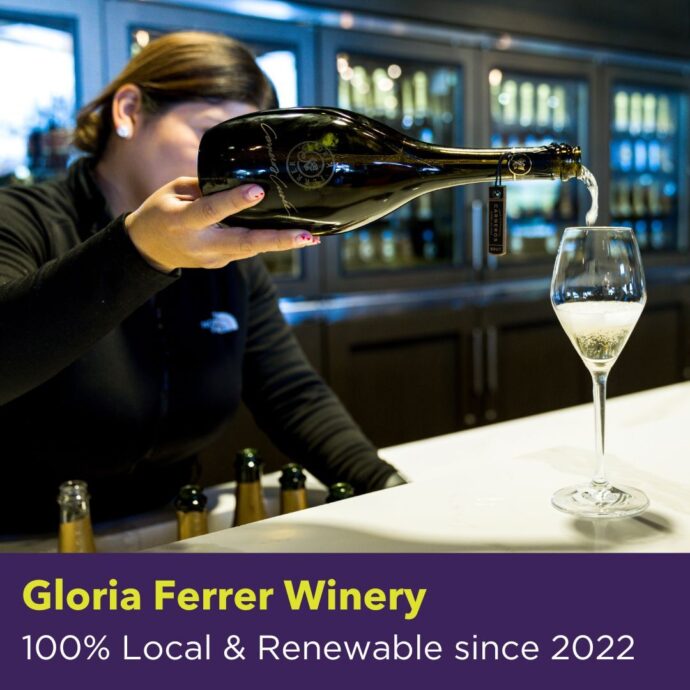Published on 09/12/2023
Sustainability isn’t just a buzzword for Gloria Ferrer Winery. It’s a deciding factor in every decision they make.
“No business decision is made without considering the impact on our community and environment,” explains Melanie Schafer, Vice President of Marketing and DTC Sales.
“It can be something as simple as whether or not to include a physical thank-you card in our orders, or as big as adding electric tractors to our fleet. The implications are always considered.”
Gloria Ferrer switched to Sonoma Clean Power’s 100% renewable and locally generated EverGreen service in January of 2022. Their power may be local, but their climate action plan is global.

In the 1980s, José and Gloria Ferrer’s son Pedro moved from Barcelona, Spain to Sonoma, California in search of the ideal region in which to produce sparkling wine. He settled on Carneros.
The dynamic climate, influenced by the cooling breezes of the San Francisco Bay and the Pacific Ocean creates a long growing season that allows the grapes to mature slowly with a good balance of sugar and acidity perfect for sparkling wines.
In 1984, the first 50 acres of their vineyard was planted. In 1986, Gloria Ferrer Winery officially opened its doors.
The climate of Sonoma County has warmed substantially over the last 60+ years. Until now, this warming has only contributed to increases in the quality of wine produced in the region.
But there’s a growing concern among vintners that a tipping point has been reached, and that continued warming in the region will make winegrape production unsustainable.
Harry Hansen, Senior Vice President of Winemaking and Winegrowing at Gloria Ferrer was with the company when it first opened in 1986. After returning to the company in 2021, he believes he’s witnessed this change first-hand.
“Coming back after being gone for 20 years, the first season the fermenters did not smell like they did in the 80’s and 90’s. They were much more tropical, and the acidity was not as strong it used to be,” said Hansen.
“That’s all the effect of global warming. People may appreciate the more tropical smell and reduced acidity, but we’re on a continuum – where does it stop? We all understand that it can’t continue to shift, and we need to do our part to turn it around,” he added.
Coming back after being gone for 20 years, the first season the fermenters did not smell like they did in the 80’s and 90’s. They were much more tropical, and the acidity was not as strong it used to be,

Senior Vice President of Winemaking and Winegrowing
Gloria Ferrer
Gloria Ferrer’s climate action plan began simply by tackling the basics, getting rid of plastic cups and bottles, paper plates, and anything disposable. Then, their focus turned to their lifeblood – the soil.
“I was trained as a winemaker, not a farmer, so it took me a while to learn that dirt really matters,” said Hansen. “Soil is like a bank account, you need to make deposits or it won’t sustain.”
This led to growing more than just grapes on site. “We looked at our restaurant and started thinking about what we could grow locally, and compost all the waste,” said Schafer. “Anything not grown onsite is provided by local producers who practice sustainable harvesting.”
In the summer of 2021, Gloria Ferrer joined International Wineries for Climate Action, a collaborative working group of wineries committed to reducing carbon emissions across the industry and achieving net zero emissions by 2050.
The IWCA has members spanning continents, who not only help each other reach their goals based on strict UN standards, but share strategies and best practices to wineries looking to accurately measure and reduce their own greenhouse gas emissions.
In January 2022, Gloria Ferrer switched to Sonoma Clean Power’s 100% renewable and locally generated EverGreen service. “We live and die by our land, and need to do the right thing,” said Schafer. “It may be more expensive, but you can’t put a price tag on doing the right thing.”
Gloria Ferrer understands that real sustainability goes beyond the winery. As a company, they are also looking to change the habits of their customers.
“We’re not going to stop shipping wine, but can we get our customers to order three times a year instead of six, and buy 8 bottles instead of 4? Decisions like that make a real difference in their carbon footprint, but it takes time to change consumer behavior,” said Schafer.
A partnership with Cloverly also helps to offset all carbon emissions generated by their direct-to-consumer shipments.
Their approach is about building a comprehensive sustainability model that includes employees, consumers, the wider community, and of course, future generations.

While Gloria Ferrer has already made considerable strides in sustainability, the winery is anything but complacent about the future. They're constantly looking for innovative ways to lower their carbon footprint and increase operational efficiency, including looking for a supplier of sparkling wine bottles that doesn’t have a large carbon footprint attached to it.
Their approach is about building a comprehensive sustainability model that includes employees, consumers, the wider community, and of course, future generations.
“On a personal level, I wasn’t as focused on sustainability until my grandson was born,” says Schafer. “What is he going to be left with? The world doesn’t look so great for him, and I want him to have the same opportunities I did growing up.”
“When I have as many years invested in a place as I have invested here, you want this place to be as special to someone else as it’s been to me,” adds Hansen. “We all have to do it sooner or later. Let’s get out in front and show the people what we can do.”